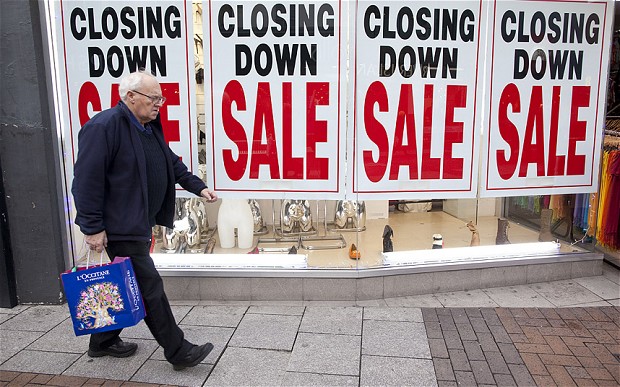A Post-Apocalypse Survival Guide for Retailers
Brent Franson CEO at Euclid Analytics
www.linkedin.com
In August, Macy’s announced that it will be shutting down another 100 stores, about 15% of their total store footprint. According to recent reports, that’s second only to Sears. This month, news reports indicate that Marks & Spencer, a UK stalwart, may shut down its Paris store – and that some wanted to pull out of international locations altogether.

For traditional retailers, these are not new headlines – nor will they be the last ones we see, especially in a post-mobile, post-Amazon world that’s disrupting a retail paradigm that’s literally thousands of years old.
To evolve – and quickly – retailers need to follow this three-step process:
- Reduce store footprint
- Focus stores on experience and personalization, and online sites on convenience
- Create a single view of customers across both online and offline
Here’s why.
Macy’s was built for a world that no longer exists. In the pre-mobile world, in which retailers like Macy’s came to power, stores stayed in one place – as physics demands and the shoppers ventured to the store. Call this the “Kids, get in the minivan – we’re going to the mall!” model of retail. Success in this world was predicated on opening as many profitable stores as possible, a logical move given that was literally the only place for consumers to buy products.
In contrast, today 44 percent of the U.S. population now lives within 20 miles of an Amazon warehouse. In a post-mobile world, the store and the products to come to you. And because virtually every store in the world is accessible from the palm of your hand and the products show up at your doorstep, the role of the physical store has changed dramatically. Digital experiences cannot fully replace those of physical stores, but a large store footprint is no longer required to compete in this dynamic retail landscape. In fact, it can be a costly impediment.
A smaller store footprint is a natural step in the evolution of moving from a pre-mobile world to a post-mobile world. Macy’s is doing the right thing by following the first step in the retail evolution playbook.
Think differently about the role of the store. The next step for Macy’s is ensuring their remaining stores are built for a modern consumer, one who demands personalization and product expertise all wrapped up in a compelling experience.
The convenience of simply having access to products is no longer a differentiator, so retailers should retool stores to focus on providing the consumer with brand experiences that are difficult or impossible to recreate online. Simply put, online retail is optimized for convenience and the physical store should be optimized for experience.
Apple has set the bar for doing this well: create a beautiful physical space that is built for experiencing products and interacting with experts. Touch, feel, and play with the products. Talk with a hip millennial who expertly guides you through the process of understanding the latest product or integrating the all of the pieces of your digital life – all things that can’t be done online. When you know what you want, you can go to the site and order it for pickup in the store or to be sent to your home or office.
Traditional retailers like Macy’s win when they make the store a destination, a brand and product playground with a complementary online presence.
The store of the future requires personalization. Personalization is all around us. We used to customize a cup of coffee with simply stated preferences on the amounts of milk and sugar. Now you can order one of a dozen coffee drinks that can be further customized in a dozen other ways. Ordering a double tall cappuccino with nonfat milk and extra foam today is now as normal as a coffee with one sugar and milk was a decade ago. Where we used to choose between Coors and Bud for beer or white or red for wine, we now have hundreds (even thousands) of options to suit every conceivable preference. The same is true for cheese, bread, clothing, electronics, even cars.
Consumers who demand personalization across the full spectrum of their buying experiences are forcing traditional retailers to confront and rethink the role of increasingly dynamic and nuanced inventories that address a wider range of consumer desires. Accordingly, this more complex shopper requires retailers like Macy’s to hire and train a more knowledgeable store associate and offer products that feel tailored to them as individuals.
Retailers need a single view of customers across offline and online channels. You can’t create a personalized, efficient experience for a customer without a single view of that person to help shape and inform every interaction.
Amazon and Apple are really the industry standard-bearers for doing this well – with a single view of each and every customer tied to either their Amazon account or Apple ID. Safeway is another standout, with an estimated 98 percent of transactions tied to customers’ Club Cards; Starbucks too is setting a great example with a valuable app experience that is resonating so well that transactions are increasing by 20 percent.
Regardless of how it’s executed, a single view of all customer interactions is vital to surviving in this new era of retail. One hint here: We don’t use Amazon because of loyalty to Amazon but because of loyalty to ourselves. It saves us time and money. Retailers should do the same for their customers and in so doing, they’ll head in the right direction.
Technology for the sake of technology is the wrong answer. Good technology is invisible. It makes for a substantially better experience while doing the work entirely – or nearly entirely – in the background. Think about the recommendations for Amazon and Netflix. The choices they curate for you don’t appear intrusive or ineffective, but merely helpful, timely and relevant. Make no mistake, however: algorithms behind the scenes are shaping and driving this highly tailored experience.
Macy’s and other retailers attempting to adapt in this new world, need to think about technology that will help create more compelling experiences. That starts with finding the useful, actionable data in a sea of worthless or distracting data. Retailers must begin with a strategy that gives them a single view of customers across both online and offline channels. Macy’s needs the equivalent of an Apple ID for their customers, a single place in which all customer interactions and purchases are united to build a shopping experience tailored for the individual that can scale.
